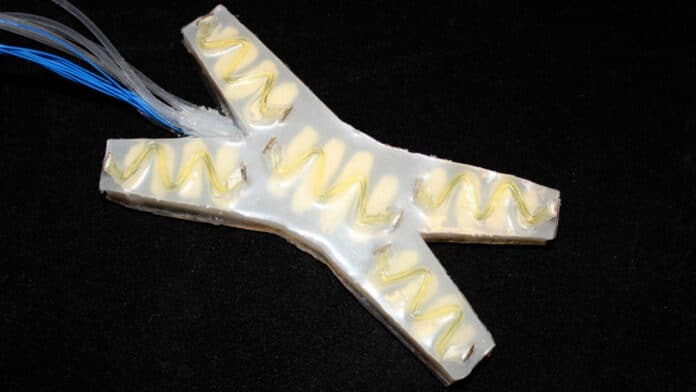If robots are going to venture into a remote environment that humans can’t reach, such as deep underwater or distant outer space, they won’t only require power and a means to get there, but they’ll also need to take good care of themselves.
To that end, a team of engineers at Cornell University had combined optical sensors with a composite material to create a soft robot that can detect when and where it was damaged – and then heal itself on the spot.
“Our lab is always trying to make robots more enduring and agile, so they operate longer with more capabilities,” said Rob Shepherd, associate professor of mechanical and aerospace engineering at Cornell Engineering. “The thing is, if you make robots operate for a long time, they’re going to accumulate damage. And so how can we allow them to repair or deal with that damage?”
For such a repair to occur, the robot must be able to identify first that there is, in fact, something that needs to be fixed.
For years, Shepherd’s Organic Robotics Lab has used stretchable fiber-optic sensors to make soft robots and related components – from the skin to wearable technology – as nimble and practical as possible. In fiber-optic sensors, light from a LED is sent through an optical waveguide, and a photodiode detects changes in the beam’s intensity to determine when the material is being deformed. One of the virtues of the technology is that waveguides are still capable of propagating light if they are punctured or cut.
The research team combined the sensors with a polyurethane urea elastomer that incorporated hydrogen bonds for rapid healing, and disulfide exchanges, for strength. The resulting SHeaLDS – self-healing light guides for dynamic sensing – provides reliable dynamic sensing at large strains with no drift or hysteresis, is resistant to punctures, and self-heals from cuts at room temperature with no external intervention.
To test the technology, the researchers installed the SHeaLDS in a soft robot resembling a four-legged starfish and equipped it with feedback control. The soft quadruped protected by SHeaLDS was able to detect and self-heal from extreme damage (e.g., six cuts on one leg) in about a minute. It could also monitor and adapt its gait based on the damage condition autonomously through feedback control. The material is sturdy, but it is not indestructible.
“They have similar properties to human flesh,” Shepherd said. “You don’t heal well from burning or from things with acid or heat because that will change the chemical properties. But we can do a good job of healing from cuts.”
Shepherd plans to integrate the SHeaLDS with machine learning algorithms that recognize tactile events to eventually create “a very enduring robot that has a self-healing skin but uses the same skin to feel its environment to be able to do more tasks.”
Journal reference:
- Hedan Bai, Young Seong Kim, and Robert F. Shepherd. Autonomous self-healing optical sensors for damage intelligent soft-bodied systems. Science Advances, 2022; DOI: 10.1126/sciadv.abq2104
